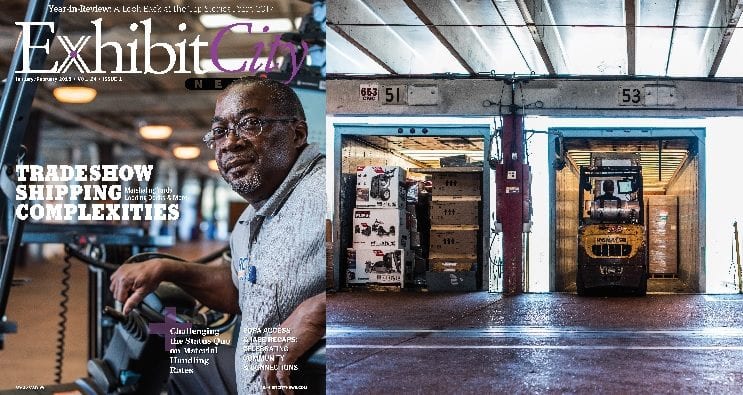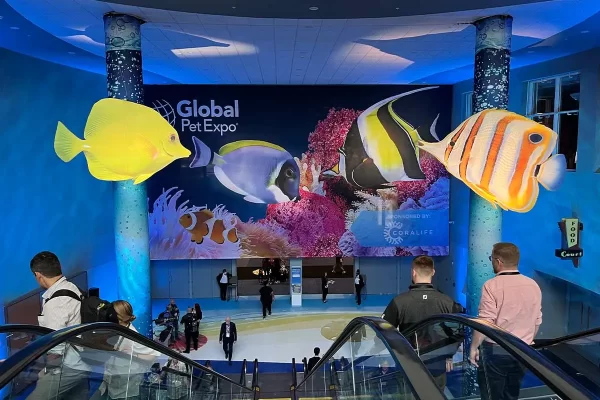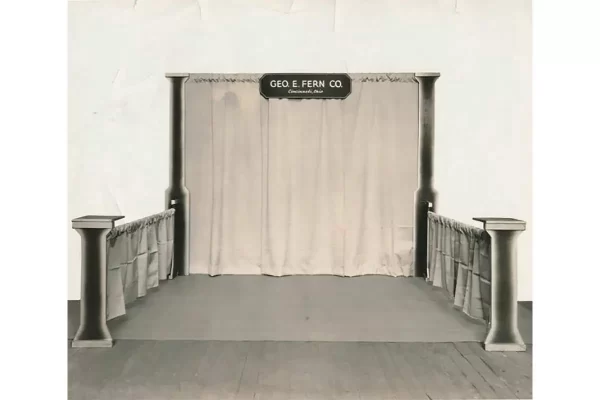Expertise in Marshaling Yards, Loading Docks, and Where To Be When Saves Time and Money
by Amber Johnson
As company belts tighten and exhibit managers search for ways to cut costs, the low-hanging fruit is often transportation – namely what a company spends to move freight to and from a trade show. After all, shipping costs are padded with plenty of luxury and convenience items like air-ride trucks, free storage, and hired logistics professionals, and trimming those costs won’t impact the customer, right? Well, not so fast.
The reality is that you get what you pay for, shipping experts say, and hiring a budget-priced common carrier or handling all the logistics in-house might seem to save money on the front end but, in fact, can end up costing a program much more in the end.
Why? Because trade show shipping is a unique animal, unlike any other in the freight moving universe, and there are 1,000 ways for it to go wrong. The unaware, the ill-prepared, and the time-strapped are often headed for disaster which, at best, can mean spending thousands on penalties or repairs, and at worst can mean not having an exhibit for the show at all. “Shipping for trade shows is very complex,” says Jason Olinger, a director in exhibit sales and operations for YRC Freight Inc. “It’s probably the most complex kind of shipping there is. It’s so important to hire someone who understands the rules of engagement for trade shows and specializes in them.”
Navigating advanced receiving warehouses or targeted move-in dates, marshaling yards, loading docks, and where to be when can come as an unpleasant surprise for a trucker not skilled at the trade show grind. “The time windows are crazy,” Olinger says. “If someone chooses a carrier that doesn’t understand the rules, they might get there at the wrong time and then have to wait all day. Drivers may be very unhappy if they show up and don’t understand that they have to sit in line for seven or eight hours.”
That estimate for wait time probably wasn’t included in the low-budget quote, but it almost certainly won’t be free either. Detention charges – times when a truck is sitting and waiting – can top $1,000 a day from some carriers, Olinger says, and he’s seen it happen.
There are fines and fees from show organizers, too, for shipments that arrive too soon and too late, and if freight isn’t picked up on schedule after the show, it will become forced freight at an exorbitant cost to the exhibitor. Indeed, transporting goods on schedule and navigating the marshaling yard and loading docks of a trade show is like threading a needle, and somebody along the way needs to have perfect vision if it’s going to go well.
That expertise can come from a variety of places, says Sean Roberts, executive vice president of XS Origami and a long-time industry consultant. Some companies have freight-moving capabilities within their own shipping departments, or have a veteran exhibit manager who can oversee logistics. Many companies entrust shipping logistics to their exhibit houses, while others hire a stand-alone logistics company that manages the process. And some companies work directly with the transportation carrier, particularly if it is the hybrid sort that provides a high level of logistics along with freight moving. There is no single right answer when it comes to trade show shipping, Roberts says, even for trade show managers being pressured to take on logistics management in-house. “It depends on experience. For the last 20 years, we’ve been training exhibitors and certifying them,” Roberts says, “and there are some who are highly qualified to do it. But really, do they have the time? Whether you’re talking about North America or overseas, there is a lot involved with shipping. I like to use logistics companies and I think most exhibit houses do too.”
Regardless of who is the shipping expert, every program needs one, plus a driver with trade show experience, advises Shane Stanley, president and founder of SEMPER Fi Logistics Group Inc. Stanley started a niche logistics company serving only trade shows and events because he knew the industry needed more specialists who understand the unique logistics surrounding exhibitions. Shipping, he says, is not the place where exhibit managers should be trying to cut corners. “Using a logistics professional is not always going to be the cheapest price,” Stanley says, “but you’re probably not going to get the same service if you go with whoever is cheapest. You might luck out on a show with one of those carriers, but even that is not very common.”
Even though they are logistics experts or because of it, the staff at SEMPER Fi never hires carriers that don’t have experience with trade shows. “It’s not worth it to hire a bargain-basement trucker so we can save $50 on a shipment,” Stanley says. “We make our money on long-term relationships with repeat business.”
Though his company does not exclusively handle trade shows, Olinger says the trade show division at YRC Freight is a specialized unit that employs 20 exhibit managers who each serve a major trade show city in North America. As one of the largest trade show transportation companies in the country, it has an economy of scale that is hard to compete with, and it’s one of the reasons Olinger says exhibit managers should not rule out large companies if they are trying to save money. “If you choose someone who doesn’t do trade shows,” Olinger says, “they might take two shipments to a show and I might have 400 to the same show.” That volume allows the company to be competitively priced and earns it some special treatment in the truck yard. For example, YRC Freight doesn’t charge detention fees to its clients, Olinger says, because it is often given specific appointment windows at the loading docks rather than being forced to wait all day to load and unload.
A company does not have to be large to gain preferential treatment like that at trade shows, Olinger says, but it must have built a network in the industry that a staff can only really create if they specialize in trade shows. “The key is relationships,” he says. “No other vertical is built on relationships like trade show shipping.”
Stanley agrees, and notes that even if an exhibit manager has the experience to manage all of the logistics in getting to and from a show, they may not have the time to develop those relationships, some of which can result in cost savings. “We have partners in place in every large market where we can store exhibits in between shows at no charge to our client,” Stanley says, adding that it took a long time to create those relationships. “This is not an easy industry. Let us deal with the intricacies of it. Exhibit managers are going to spend a lot of energy trying to accomplish something we already have a system for, and that means we are going to save them time and money.”
When budget is a concern, there are ways to conserve dollars that don’t include canning expert help. For example, because YRC Freight offers comprehensive logistics management for shippers, Olinger says, exhibit managers could forego having their exhibit house or an independent logistics firm handle shipping and contract directly with the transportation company instead. “More often than not they are calling me for the pick-up,” he says.
Many transportation companies are trying to add more sophisticated logistics management to their roster of services to become more competitive, Roberts says. He just cautions exhibit managers to be sure they are working with a company that has the equipment and experience needed for trade shows. Things like air shocks and a climate controlled trailer are essential, he says, and so is working with a trucking firm that knows how to secure fragile freight. “Common carriers usually aren’t designed for carrying exhibits,” Roberts says, “they are designed for boxed freight like the kind that is going to Costco. If you put an exhibit in the back of one of those trucks, it will bounce all over the place.” In fact, Roberts has seen exhibits bounced to pieces from not being secured properly, and he’s seen displays that all the glue crumbled off of because they couldn’t withstand the freezing temperatures of a mountain pass en route to the show.
But bypassing a logistics firm may not help an exhibitor save what they could by using the firm’s expertise. “You need to talk to your logistics company and ask them what they can do to help reduce costs,” Stanley says. “We know the cost of shipping can make or break the profit line for a client, and we want to help them. Logistics professionals can offer the world if you just talk to them about what you need.” Stanley says whether it is a client renegotiating for certain services, mapping out a more efficient shipping route, or changing the manner in which they ship, there are things a neutral logistics provider might be better equipped to address than a trucking company or exhibit house.
But people fretting over the budget need to talk to their exhibit houses as well, Roberts says. “If they are worried about cost, ask for a design with lighter materials,” he says, noting that shipment weight and size have the greatest impact on what it costs to move freight. He recommends starting that conversation nine months to a year ahead of shows, particularly if the timeframe could capitalize on the exhibit house’s down time.
Though he acknowledges it is not an idea that is necessarily popular with exhibit houses, Roberts suggests exploring furniture rental, especially as the inventory of available pieces has grown into the unique and sophisticated. “The reality of renting is, when you’ve got companies like Cort out there, why ship a chair when you can rent a chair?” he says. Moreover, why ship video screens or monitors when they are so fragile and there is an abundance of companies renting them now, he asks. “Exhibit houses may want to sell you those things, but you will save money if you rent them,” Roberts adds.
Multi-year contracts with rental, logistics, or transportation providers can help drive down costs too, Roberts says. “You’ll need to lay out your full program and see if you can achieve an economy of scale by signing a contract for all of your shows. It takes time to develop those contracts, but you can get a bargain,” he says.
Exhibit managers need to advocate for better prices with existing suppliers, and they should ask for all shipping or service quotes in writing when looking for new partners. Roberts also recommends reviewing at least three potential suppliers rather than just one, and he warns managers to not feel pressured to sign a contract before they have compared several companies. “There’s no way around it, if your company doesn’t have a contract, then you are going to have to do research,” he says, adding that networking with unbiased exhibit consultants or peers can be valuable when vetting options.
Also, Roberts says, exhibit managers should not be afraid to ask their exhibit house for ways to cut costs. “The best way, bar none, is to listen to the exhibit house,” he explains. “They are not trying to steal your money. They don’t ask what your budget is to see how much they can squeeze out of you – they need to help you break it down.” Just like transportation companies and logistics professionals, exhibit houses have a vested interest in a client’s success, Roberts says, and will likely have a number of ideas to help them trim the shipping budget – ideas that don’t include managing without an expert.
And there is no shame in exhibit managers not knowing everything themselves, Olinger says. “We know we are dealing with people who aren’t transportation experts and we don’t expect them to be,” he says. Whether it’s helping them print labels or plan out their shipping timeline, Olinger says they are there to help. “We want them to have a successful transportation experience,” he says, “and sometimes they don’t know what they don’t know.”
Stanley sees part of his company’s function as a logistics manager as that of teacher, helping his clients get learn the ropes. “I know what’s required and so I make sure we’re asking for it when a client is shipping items,” he says. “We are teaching them in the process because we become part of their team and want to help them.”
When it comes to trade show shipping, Roberts thinks a good rule of thumb is to pay more now instead of paying even more later to fix something. And whether they are getting lessons from their suppliers or certification courses or their peers, learning the ins and outs of moving freight can only lead to better decisions for exhibit managers, Roberts says, even if the decision is to not do it themselves. “They are not going to learn it overnight,” he mused, “but it would benefit them to become quickly educated, and not through the school of hard knocks.”
This story originally appeared in the January/February 2018 issue of Exhibit City News magazine, pp. 20-23 For more pictures and original layout, visit https://issuu.com/exhibitcitynews/docs/jan-feb_ecn2018.




























